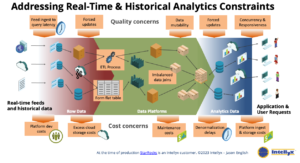An Intellyx BrainBlog for CelerData, by Jason English
 Real-time data is wired, historical data is tired. Or is it?
Real-time data is wired, historical data is tired. Or is it?
Real-time data represents the future of analytics. So much so that it seems most industry analysts, including Intellyx—are constantly being asked to cover real-time data topics—because event-driven architectures are where the streaming edge of innovation seems to be happening these days.
Real-time represents reality. There’s significant business value to be gained, in terms of predictive accuracy and business agility, from only working with the freshest possible real-time data. It must be way more valuable than that old, historical data.
But wait a minute.
Technically, real-time data becomes historical data the very moment it is stored in a volume somewhere. So historical data doesn’t necessarily mean ‘old data’ anymore. Most of the data we deal with is actually historical, and will still be, for the known future.
After all, what good is knowing the velocity of a fast-moving object, if you have no data to understand where it just came from, and the trajectory it’s heading toward?
Why historical data matters
Mark Twain once said that “History never repeats itself, but it does often rhyme.”
Perhaps industry analysts and experts have been lax in overlooking the value of bringing existing analytics applications and historical data to the table.
Take an e-commerce analytics example, where the only ‘real-time’ part of the data is new orders coming in through a payment gateway, or customer messages to a feedback app. There’s not much a digital business leader could take away from such information in terms of charting a future course.
Yes, the real-time data may tell the executive that there is some activity at this moment, but it’s hardly indicative of a trend unless this moment is compared to other ranges of similar times the business has existed in.
As a decision maker in the e-commerce company, I would need good historical data next to my real-time data for spotting cyclical or seasonal trends. More than that, I would also want to build models and scenarios for responding to events such as unexpected shifts in demand and inventory as well.
Read the full article and download this Infographic on the Celerdata (StarRocks) blog here: https://celerdata.com/blog/doubling-the-analytic-wealth-of-unified-historical-and-real-time-data



